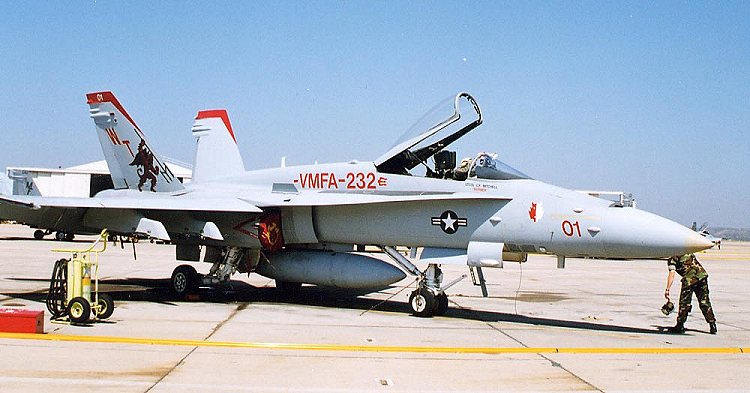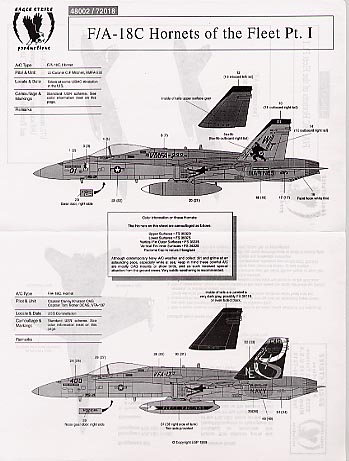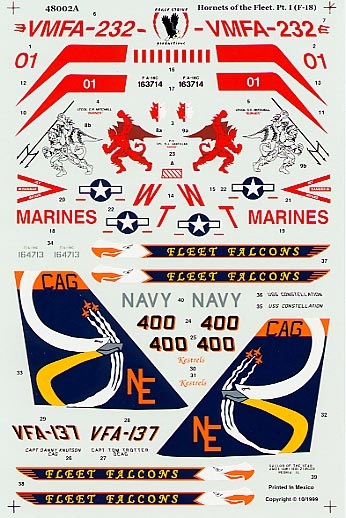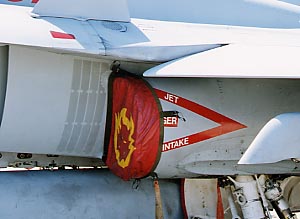
|
Sheet # |
Eagle Strike 48-002 for F-18 Hornet |
|
Price: |
$9.00 |
|
Units: |
see review |
|
Review By: |
|
|
Notes: |
|

 All plane modelers who have spent any
amount of time around real planes have a "need-to-build" subject. The
subject is inevitably a model of the real plane with which they have that
association. That plane has a special place in the heart that has a time and
place connected with it. Workers on the Boeing line want 737ís, 777ís, and
747ís. Plane Captains and mechanics always want to do the "their"
plane. For Scott, it might be probably be Top Gun A-4ís or Pacific S-3ís
(although Polish observation aircraft is equally compelling). Often the
relationship does not have to be direct, but the real aircraft is a definite
reminder of a time and place (i.e. last job, a tour overseas, a career-making
important business deal, etc.).
All plane modelers who have spent any
amount of time around real planes have a "need-to-build" subject. The
subject is inevitably a model of the real plane with which they have that
association. That plane has a special place in the heart that has a time and
place connected with it. Workers on the Boeing line want 737ís, 777ís, and
747ís. Plane Captains and mechanics always want to do the "their"
plane. For Scott, it might be probably be Top Gun A-4ís or Pacific S-3ís
(although Polish observation aircraft is equally compelling). Often the
relationship does not have to be direct, but the real aircraft is a definite
reminder of a time and place (i.e. last job, a tour overseas, a career-making
important business deal, etc.).
For me, would its Hornets of VMFA-232 "Red Devils", VMFA-212 "Lancers", and VMFA-235 "Death Angels". When I was stationed at MCAS Kaneohe Bay (jeez- ten years ago) these three squadrons were based there as well. They formed the fast jet component of a unique command, the 1st Marine Expeditionary Brigade. The 1st MEB consisted of the F/A-18 squadrons, four CH-46 squadrons, a CH-53 squadron, an infantry regiment, an artillery battalion, a service support group, and other units of various designations. What made 1st MEB so special was that all the units werenít dispersed throughout three or four separate bases. They were all co-located on one base within five minutes of each other. Exercises and overseas deployments were usually done within elements of or the entire MEB. As a result of such close proximity and association, a tight familiarity formed between the air, ground and support elements. Around 1994, the MEB, as a single command, stood down. Eventually, all the jets and some of the helicopter squadrons left Kaneohe Bay. When I was in Japan, I saw VMFA-232 and VMFA-212 again. When I ended up at Miramar, there was VMFA-232, too. It was like having a neighbor follow you around on three cross-country moves for six years.
 Eagle Strike Productionsí sheet 48002
Hornets of the Fleet Pt.I features the Red Devils COís jet as appeared
around 1997, my last year at Miramar. Having observed Red Devilís Hornets for
the previous five years, this was the most colorful scheme to date. Too often,
color on Navy and Marine Corps jets is applied just using the same stencils as
the lo-vis version. This Red Devil jet was unique in the application of the
huge, hand-painted Red Devil on the tail and judicious use of red paint. Eagle
Strike divided the complex Red Devil into three colors and two decals to
replicate the complex original. Itís no surprise that Dave Roofís name
appears on the sheet, he was still at Miramar around that time.
Eagle Strike Productionsí sheet 48002
Hornets of the Fleet Pt.I features the Red Devils COís jet as appeared
around 1997, my last year at Miramar. Having observed Red Devilís Hornets for
the previous five years, this was the most colorful scheme to date. Too often,
color on Navy and Marine Corps jets is applied just using the same stencils as
the lo-vis version. This Red Devil jet was unique in the application of the
huge, hand-painted Red Devil on the tail and judicious use of red paint. Eagle
Strike divided the complex Red Devil into three colors and two decals to
replicate the complex original. Itís no surprise that Dave Roofís name
appears on the sheet, he was still at Miramar around that time.
A few notes about the real Red Devil Boss jet. Instead of full-length walkways on the LERX, it abbreviated one that ended before the LERX fences. This plane didnít have the latest features of the F/A-18C. Consequently, they have straight antennas on the spine and behind the nose gear door, the old SJU-6 seat, the original vents for the gunbay, the original straight centerline pylon, stiffeners inside the tail, and only one chaff bucket next to each intake. What this means for the modeler is that the Monogram C kit has all these features straight out of the box. For the Hasegawa C kit, the only modifications are to fill the lines for doors 5L and 5R on the nose, sand off the antennas next to the chaff buckets, omit the stiffeners inside the tail and reverse the order of the antennas on the right nose gear door.
Also on the sheet are markings for VFA-137 the Kestrelís CAG bird. Since the design encompasses the entire tail, decals for the Hasegawa and Monogram kit are included. I canít comment much on this bird because Iím prejudicial toward Marine jets and against designs that look like flying buttcheeks. Nevertheless, since the original had a hand-painted portion added to the color stencils, the two sides of the tail are not identical. The sheet reflects this.
Also included with sheet are two smaller sheets for stencils and the aforementioned Hasegawa version of Kestrel design. Since Red Devil jet did not have extensive stencils, there are enough markings to do both aircraft. The sheet runs for about $9.00 and is (for me) worth very penny to do a plane that reminds me of so much.
Below are some close up images that you might find useful when applying the decals.

 |
 |
 |
If you would like your product reviewed fairly and quickly by a site that has over 1,800 visits a day, please contact me or see other details in the Note to Contributors.